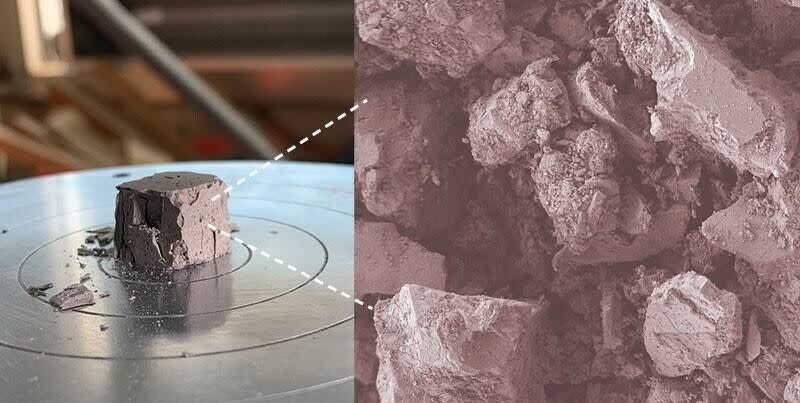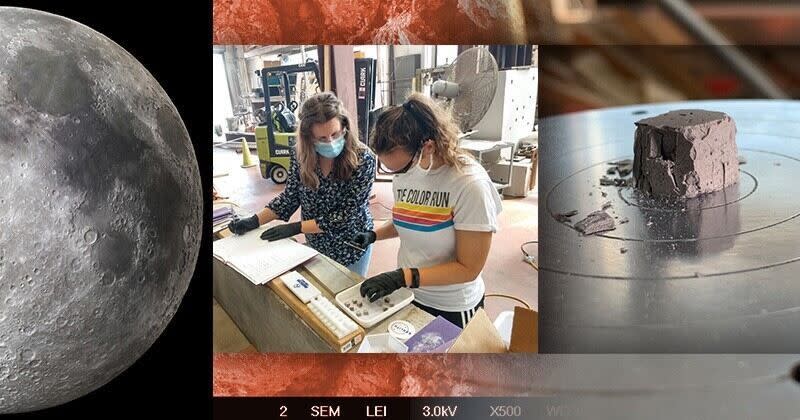This Extraterrestrial Cement Could Be the Blueprint for Moon Construction

To build on the moon, you can’t haul cement to space. You need to create it there, so engineers are exploring making geopolymer cement out of clay-like soils found in outer space.
Some clays found on Earth mimic the types of clay found on the moon and Mars.
Figuring out the binder for the clay-like topsoil is the key to ongoing research.
No matter how many bags of cement are needed to build rocket landing pads, space-strength buildings, and stable housing on the moon, that number is simply too grand to haul up from Earth.
“If we’re going to live and work on another planet like Mars or the moon, we need to make concrete,” Norman Wagner, Unidel Robert L. Pigford chair of Chemical and Biomolecular Engineering at the University of Delaware, says in a news release. “But we can’t take bags of concrete with us, we need to use local resources.”
🌘 You love our solar system. So do we. Let’s nerd out over it together—join Pop Mech Pro.
Fortunately, a research team at the University of Delaware believes those local resources exist in the form of clay-like topsoils, available both on the moon and on Mars. In a recent paper published in Advances in Space Research, the Delaware team highlights a successful conversion of simulated lunar and Martian soils into geopolymer cement, which is seen as an appropriate substitute for conventional cement. Plus, the researchers have cooked up a framework for comparing various geopolymer cements for unique uses, such as building vertical rocket pads.
Geopolymers are inorganic polymers that are made up of aluminosilicate minerals. They’re found in common clays around the world, and it turns out the moon and Mars contain clays with the same characteristics. To get a strong binder that can craft cement, the clay must mix with a high-pH solvent, like sodium silicate, which in turn allows the aluminum and silicon inside to react with other materials and form a new cement-like structure.
🌙 Moon Projects We Can’t Stop Thinking About
How to Build a Particle Collider on the Moon—And Why We Should
Digging Up Regolith: Why Mining the Moon Seems More Possible Than Ever
Maria Katzarova, a former associate scientist and member of Wagner’s lab, proposed to NASA the concept of creating extraterrestrial geopolymer cement. She eventually received funding from the Delaware Space Grant Consortium to team up with former University of Delaware doctoral student Jennifer Mills, who’s well-versed in terrestrial geopolymers. The researchers used simulated extraterrestrial soils to create geopolymer binders, then compared how each material performed.
“When a rocket takes off there’s a lot of weight pushing down on the landing pad and the concrete needs to hold, so the material’s compressive strength becomes an important metric,” Wagner said. “At least on Earth, we were able to make materials in little cubes that had the compressive strength necessary to do the job.”
The samples were also tested in different environments typically found in space, including vacuum and low- and high- temperatures. Some samples formed cement, while others did not, based on the conditions. Generally, the researchers found that a geopolymer cement’s compressive strength decreased under vacuum conditions, compared to samples that were cured at room temperature and pressure, giving insight into how each material can be made for a specific use case.

“There’s going to be a tradeoff between whether we need to cast these materials in a pressurized environment to ensure the reaction forms the strongest material or whether can we get away with forming them under vacuum, the normal environment on the moon or Mars, and achieve something that’s good enough,” Mills says in the news release.
The colder the environment, the less reaction from the materials, showing a potential need to heat the geopolymer or add a chemical kickstarter for the reaction in certain environments. And the hotter it was, the stronger the moon-like samples got.
The team ensured that a finished product wouldn’t rely too heavily on materials hauled from Earth, which could overtax rocket payloads. Instead, it focused on what’s available on the moon and Mars, increasing the plausibility of space-created cement.
“This is not a trivial thing,” says Wagner. “You can’t just, say, give me any old clay and I’ll make it work. There are metrics to it, chemistry that you have to worry about.”
And there are implications for the use of this technology right here on Earth. Compared to conventional cement, geopolymer cement can be created from a wider variety of materials and requires less water, which would prove useful in water-scarce areas.
You Might Also Like

